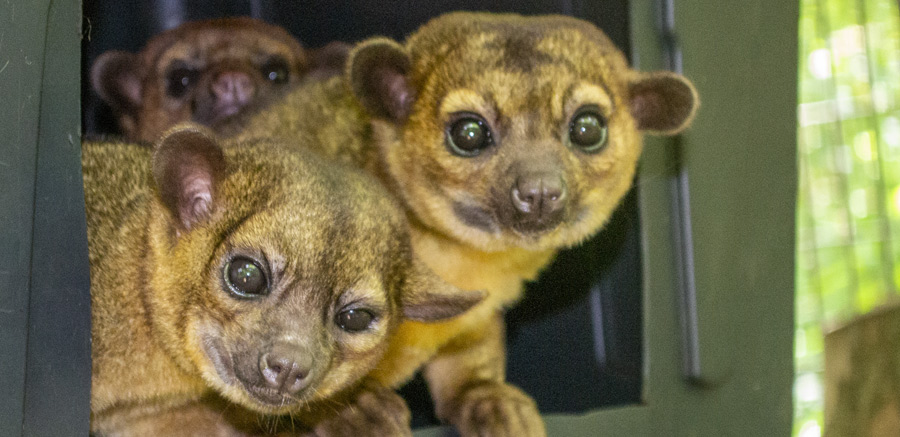
KINKAJOU
Kinkajous are commonly referred to as “honey bears.”
PROFILE
Honey can be a little grumpy sometimes, but she lets you know by letting out a little squeak if you get too close. She is still very sweet though! Loki is our male and he is missing a patch of fur on his left shoulder blade from where he had some food that the girls wanted. He wasn’t injured, they just pulled some fur out. He is the sweetest of the three and usually the first to jump on a keeper when they walk in. He is also the most curious of the three. Freya is the shyest. She was pulled from her mother a little early and suckled her paw, which is why you might notice she has a little underbite. She is also still seen with her paw in her mouth. She also has the lightest pink nose of the three.
OVERVIEW
CONSERVATION STATUS
Least Concern
AVERAGE SIZE
Compared to a 6′ Man
AVERAGE WEIGHT
Females: 15 – 40 lbs
Males: 18 – 44 lbs
AVERAGE LIFESPAN
10 – 14 Years
DIET
Omnivore
REGIONS
Central and South America
Kinkajous are found in South and Central America is the native home of the kinkajou. Here they can be found throughout Belize, Bolivia, Brazil, Colombia, Costa Rica, Ecuador, El Salvador, French Guiana, Guatemala, Guyana, Honduras, Mexico, Nicaragua, Panama, Peru, Suriname, and Venezuela. They live in the rainforests, evergreen forest, gallery forest, dry forests, and savanna. They prefer old-growth forest but at times have made use of secondary forest successfully.
APPEARANCE
The kinkajou has dense, woolly fur which is colored a golden brown with some animals displaying a grey-brown or dark brown coat. The dense fur protects them against the rain. It also helps them avoid bee stings when they forage for honey. The underbelly has orangish or yellow fur. They have short legs with five fingers at the end which are clawed for climbing trees. There is some webbing between their fingers. The feet can turn backward – an adaptation that allows them to run up and down branches easily. Their tail is as long as or longer than their head and body. It is prehensile meaning it can be used as a fifth hand, capable of grasping and holding as well as aiding in balance. They have large eyes to aid them with night vision as they are primarily nocturnal. They have a long tongue which helps them reach food deep within tree hollows. While they have sharp teeth, they are actually herbivores.

CHARACTERISTICS
Kinkajous are nocturnal animals as a means of avoiding predators. They are also solitary and typically avoid each other unless they are mating. They climb through the trees searching for fruit, flowers, and honey. They also like to eat eggs and insects. Because they eat so much fruit, they play an important role in seed dispersal. Because trees reproduce via seeds within fruit, when a kinkajou eats a tree’s fruit, what goes in must come out! If a kinkajou eats a fig, and then “releases” the seeds a mile away, that allows trees to spread in a further range.


